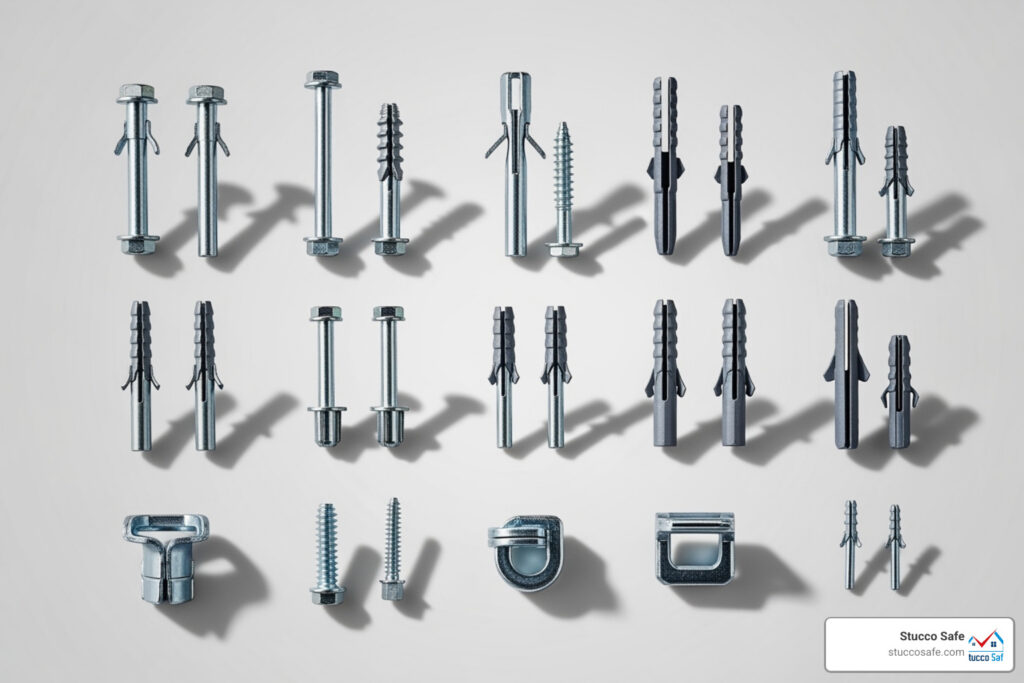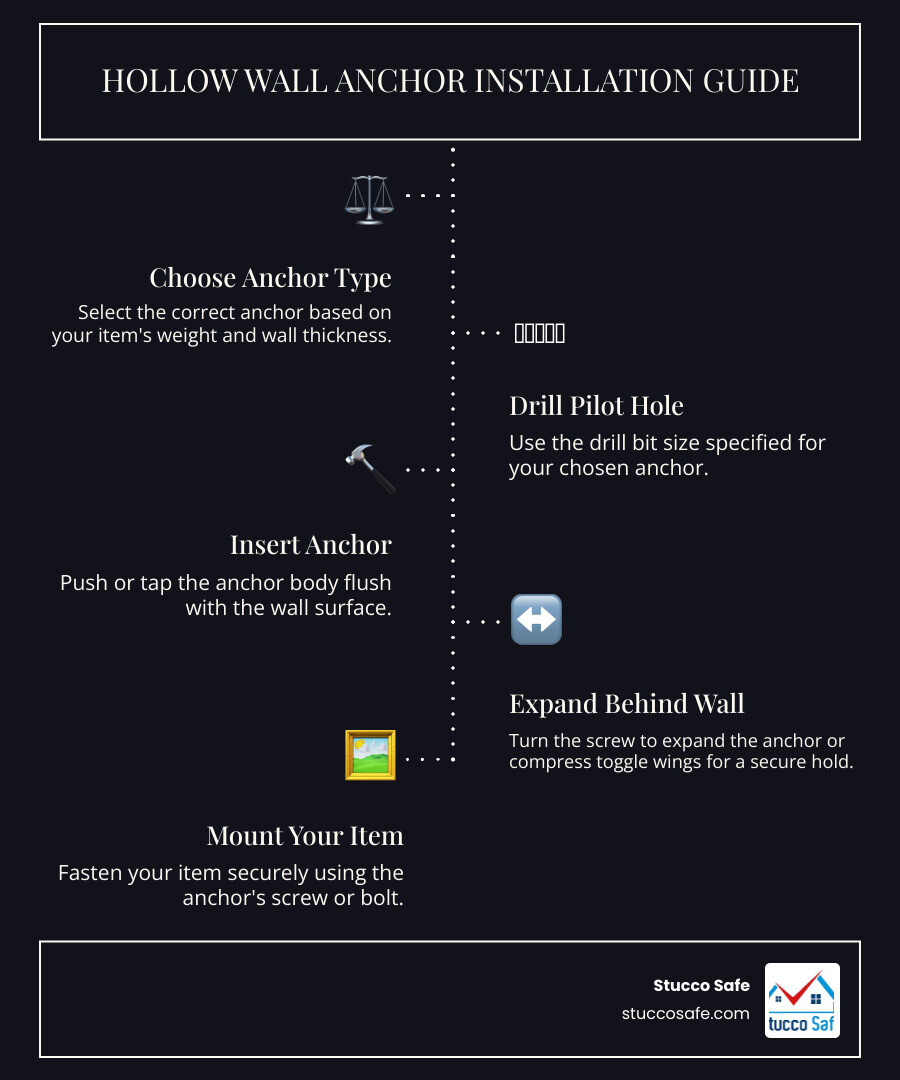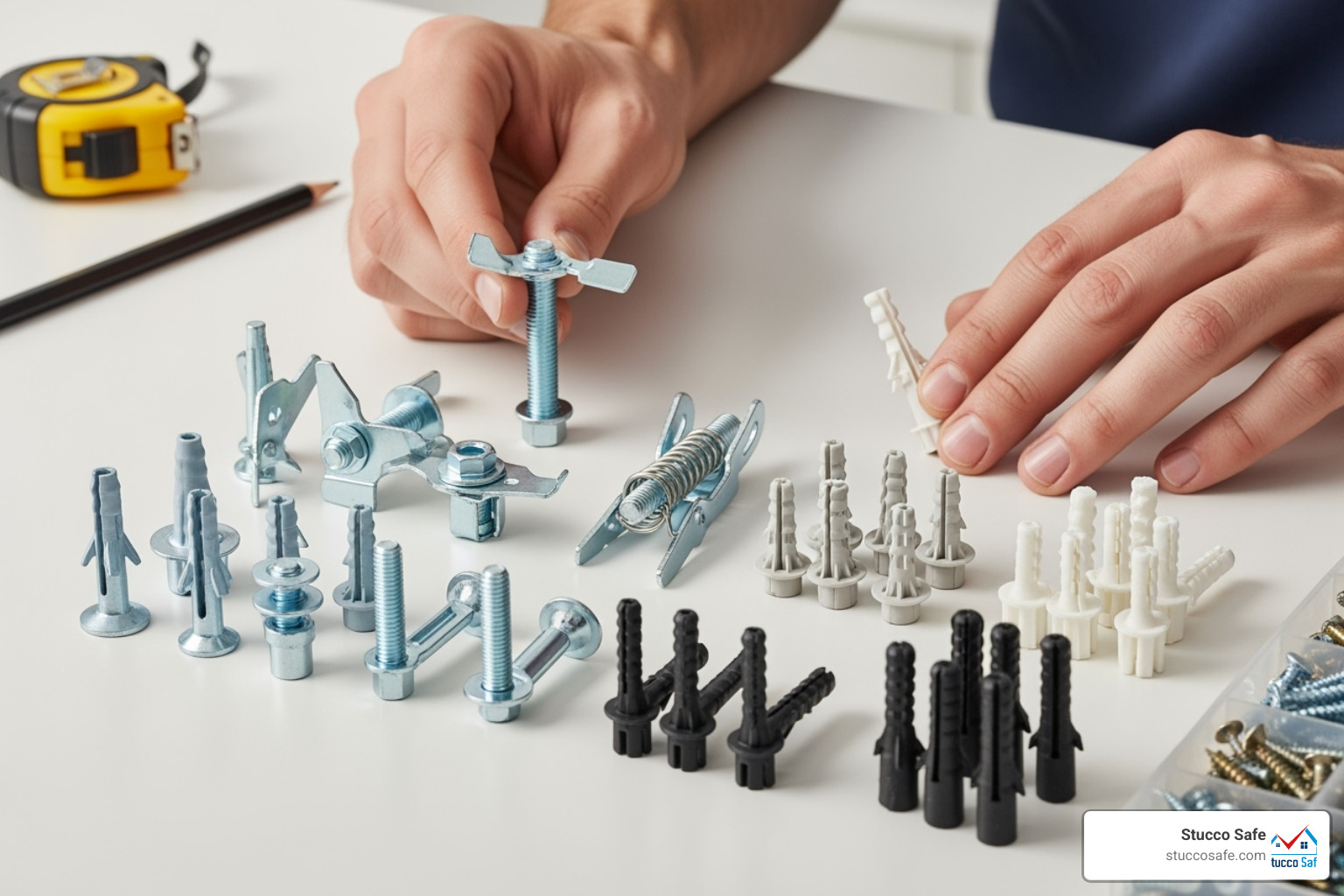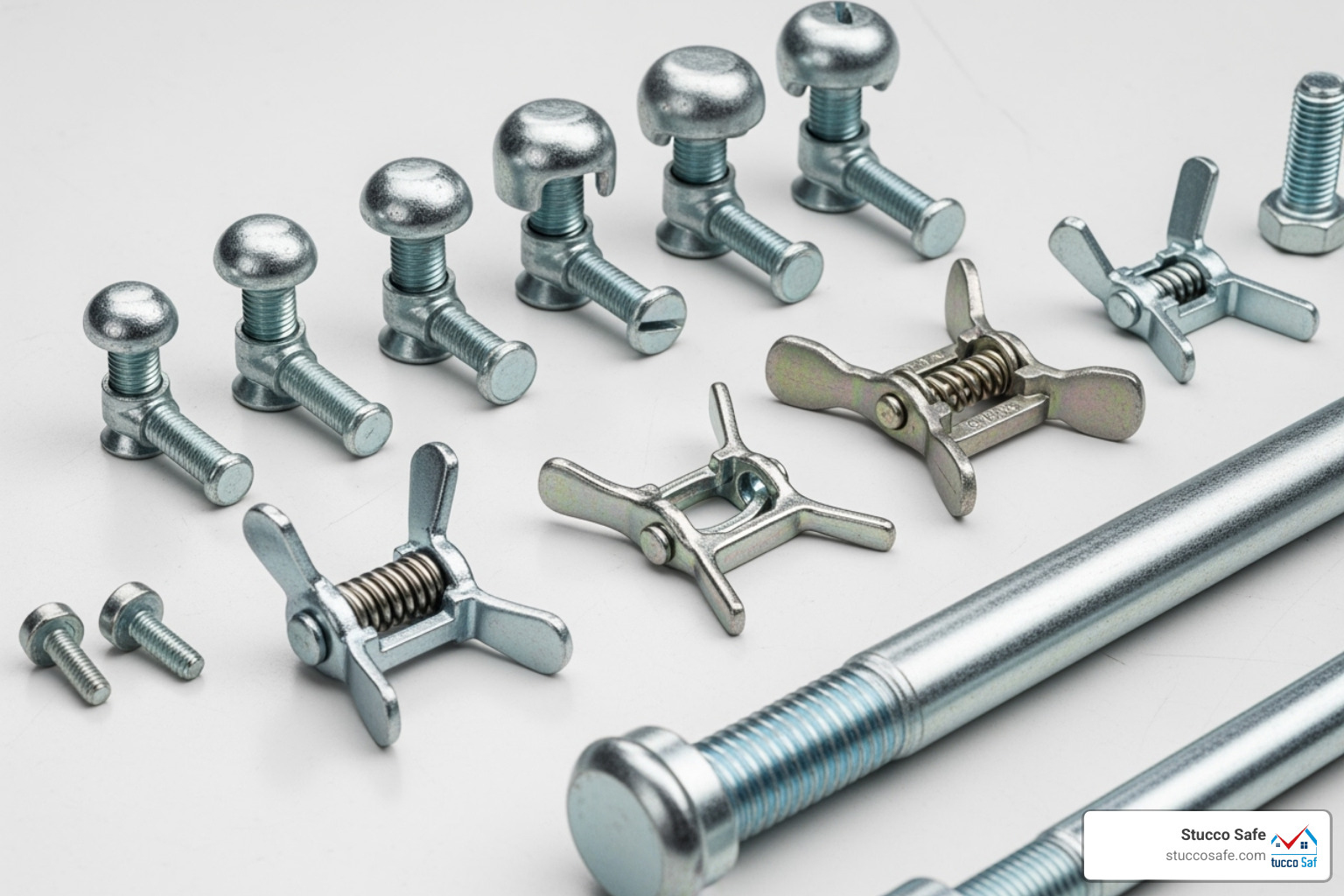Hollow wall anchors how to use: Avoid 3 Pitfalls
Why Hollow Wall Anchors How to Use Matters for Your Home
Hollow wall anchors how to use is essential knowledge for any homeowner who wants to hang items securely on drywall or plaster without causing damage. Here’s the quick answer:
Quick Installation Guide:
- Choose the right anchor – Match the anchor type to your item’s weight (10-150+ lbs capacity available)
- Drill a pilot hole – Use the correct size bit for your anchor type
- Insert the anchor – Tap it flush with the wall surface
- Expand or secure – Turn the screw to expand metal anchors, or compress toggle wings
- Mount your item – Attach using the anchor’s screw or bolt
Drywall is made of compressed gypsum between paper layers. It’s great for walls, but it has almost no holding strength on its own. A simple screw driven directly into drywall will pull out with just a few pounds of force. That’s where hollow wall anchors come in – they distribute weight across a larger area behind the wall, creating a secure mounting point that can hold anywhere from 10 to 150+ pounds depending on the anchor type.
I’m Gabe Kesslick, and while my specialty is stucco inspection and building envelope forensics, understanding how to properly mount items on various wall materials – including knowing hollow wall anchors how to use correctly – is fundamental to maintaining structural integrity and preventing wall damage. Whether you’re working with drywall, plaster, or stucco, the right fastener makes all the difference.
What Are Hollow Wall Anchors and Why Do You Need Them?
Most homeowners learn that drywall can’t hold much weight on its own. A simple screw will pull out easily because the material is just compressed gypsum. Hollow wall anchors solve this by expanding behind the wall, distributing the load over a larger area and allowing you to hang items securely.
Studs vs. Anchors: Knowing the Difference
Before using an anchor, check for a wall stud, especially for heavy items like TVs or cabinets. No anchor is as strong as a screw in solid wood. Studs are typically spaced 16 inches apart. You can find them by knocking on the wall, checking near outlets, or using a stud finder. For a reliable option, consider a magnetic stud finder like the StudBuddy, which locates the metal fasteners in the studs.
Choosing Your Champion: A Guide to Different Anchor Types
Selecting the right hollow wall anchor is like choosing the right tool for any job – it makes all the difference. The best anchor for your project depends on several factors: the weight of the item you’re hanging, the thickness and type of your wall material, and the specific needs of the project. We always recommend checking the anchor’s packaging for specific weight limits and installation instructions, as these can vary by manufacturer.
To help you steer the options, we’ve put together a quick comparison of common hollow wall anchor types:
| Anchor Type | Appearance | Weight Capacity (Approx.) | Best For
Important Note: The provided research contains internal links to stuccosa articles. As per the instructions, these internal links will be included in the The article as internal links for the CTA section at the end. The external links will be included within the body of the article as specified in the outline.
Why Hollow Wall Anchors How to Use Matters for Your Home
Understanding how to use hollow wall anchors is a fundamental skill for home maintenance, preventing damage and ensuring your belongings are secure. Here’s a quick guide:
Quick Installation Guide:
- Choose the right anchor for your item’s weight.
- Drill a pilot hole of the correct size.
- Insert the anchor until it’s flush with the wall.
- Expand or secure the anchor by turning the screw.
- Mount your item using the anchor’s screw or bolt.
Drywall has very little holding strength on its own, but anchors create a secure mounting point that can support anywhere from 10 to over 150 pounds. As a building envelope specialist, I know that using the right fastener is key to maintaining your home’s structural integrity.
What Are Hollow Wall Anchors and Why Do You Need Them?
Many homeowners find the hard way that drywall alone can’t support much weight. A screw driven directly into it will easily pull out, as the material is just compressed gypsum between paper layers. This is where hollow wall anchors are essential.
These clever fasteners work by expanding behind the wall, creating a broad backing that distributes the load, much like snowshoes spread your weight on snow. This allows you to safely mount items weighing from 10 to over 150 pounds, depending on the anchor. A single layer of wallboard can support about 15 kg (33 lbs) per square meter with proper anchors, while double layers can hold up to 25 kg.
Studs vs. Anchors: Knowing the Difference
Before reaching for an anchor, check for a wall stud, especially for heavy items like TV mounts or kitchen cabinets. No anchor can match the strength of a screw in solid wood. As The Family Handyman points out, heavy loads demand a stud.
Studs are typically spaced 16 inches apart. You can find them by knocking on the wall (a solid thud indicates a stud), checking next to electrical outlets, or using a stud finder. We recommend a simple magnetic stud finder like the StudBuddy, which locates the metal screws holding the drywall to the studs, offering a reliable, no-fuss method.
Choosing Your Champion: A Guide to Different Anchor Types
Selecting the right hollow wall anchor is crucial and depends on the item’s weight and your wall type. Always check the anchor’s packaging for specific weight limits and installation instructions.
To help you understand hollow wall anchors how to use effectively, here’s a comparison of common types:
| Anchor Type | Appearance | Weight Capacity (Approx.) | Best For |
|---|---|---|---|
| Plastic Ribbed | Plastic sleeve with external ribs and a flange | 10 lbs per pair | Light pictures, small clocks, very light decor where minimal support is needed. |
| Threaded (Corkscrew/Self-Drilling) | Plastic or metal, sharp threads, screws directly into drywall | 25-50 lbs (plastic/metal) | Small shelves, light curtain rods, picture frames, small mirrors, light fixtures. Some metal versions can hold up to 150 lbs per pair. |
| Molly Bolt (Hollow-Wall Anchor) | Metal sleeve with a pointed end, expanding sections | 30 lbs per pair (hollow-wall anchors) / 75 lbs per pair (Molly bolts) | Medium-weight mirrors, towel bars, small cabinets, shelves. Ideal for plaster, paneling, and other hollow walls. |
| Toggle Bolt (Wing-Style/Strap Toggle) | Metal bolt with spring-loaded wings or a strap | 50-100 lbs per pair | Heavy shelves, large mirrors, TV mounts, grab bars, wall-mounted storage. Provides excellent load distribution and pull-out strength. Strap toggles can hold 100 lbs. |
Light vs. Heavy-Duty Anchors
For lightweight items like picture frames, plastic ribbed anchors are a simple choice. For slightly more weight and incredible ease of use, threaded (corkscrew) anchors are excellent. Many, like the Twist-N-Lock anchor, are self-drilling, requiring no pilot hole.
When you need to hang heavier items like mirrors or shelves, upgrade to metal anchors. Molly bolts expand behind the drywall for a secure grip, holding up to 75 pounds per pair. For the heaviest loads, toggle bolts are the champions. Their spring-loaded wings open inside the wall, providing superior holding power for items up to 100 pounds or more.
The Main Event: Hollow Wall Anchors How to Use Step-by-Step
Now, let’s get to the practical application of hollow wall anchors how to use. Proper installation is key to ensuring your items stay securely on the wall.
Safety First!
Before drilling, wear eye protection and check for hidden pipes or wiring. Hitting a utility line can be dangerous and costly. For a visual guide on what’s inside your walls, see What’s Inside My Wall?. For a walkthrough of the installation process, check out this Practical Video Guide | Lowe’s.
How to use hollow wall anchors: The Molly Bolt Method
Molly bolts offer a strong hold for medium-duty items.
- Mark your spot and drill a pilot hole of the size specified on the anchor’s packaging.
- Insert the molly bolt and tap it gently with a hammer until the flange is flush with the wall. The small teeth under the flange will grip the drywall to prevent spinning.
- Turn the screw clockwise to expand the anchor’s sleeve behind the drywall. Keep turning until it feels snug and secure.
- Remove the screw, position your item over the anchor, and re-insert the screw to mount it.
How to use hollow wall anchors: The Toggle Bolt Method
Toggle bolts are the strongest option for heavy items.
- Mark your spot and drill a hole large enough for the folded toggle wings to pass through. Check the packaging for the correct drill bit size.
- Thread the bolt through your item first, then screw the toggle wings onto the end of the bolt.
- Pinch the wings together and push them through the hole. You’ll hear a “snap” as they open inside the wall.
- Pull the bolt toward you to engage the wings against the back of the drywall, then tighten the screw until your item is secure. If the bolt spins freely, it may be too short to allow the wings to open fully.
Pro Tips and Common Pitfalls to Avoid
Even with the right anchor, a few common mistakes can lead to failure. Avoid these pitfalls to ensure a secure hold.
The most frequent errors are overtightening the screw, which can strip the anchor or damage the drywall, and using the wrong size drill bit, which creates a hole that’s either too tight or too loose. Always check the anchor’s packaging for the correct bit size and tighten the screw until it’s just snug. Also, inspect your wall first; if the drywall is damaged or crumbly, an anchor won’t hold. For heavier items, consider using multiple anchors to distribute the weight.
Different wall materials require different solutions. For stucco, which has unique requirements, consult our guide on the Best Anchors for Stucco.
How to Remove a Hollow Wall Anchor
Removing an anchor is straightforward.
- Plastic & Threaded Anchors: Unscrew the screw. For plastic anchors, pull the sleeve out with pliers or push it into the wall. For threaded anchors, simply unscrew the anchor itself.
- Molly & Toggle Bolts: These are designed to be permanent. After removing the screw, the easiest way to deal with the anchor body (Molly) or wings (Toggle) is to simply tap them into the wall cavity.
After removal, you’ll be left with a hole. Fill small holes with spackle. For larger holes, use mesh tape before spackling, then sand and paint. You’ll need a screwdriver, pliers, a hammer, a putty knife, and spackle.
Frequently Asked Questions about Hollow Wall Anchors
Here are answers to some of the most common questions about using hollow wall anchors.
Why are my drywall anchors pulling out?
This usually happens for a few key reasons:
- Overloading: The item is too heavy for the anchor type you chose. Always check the weight rating.
- Incorrect Hole Size: A hole that is too large won’t allow the anchor to grip the drywall properly.
- Damaged Drywall: Old, crumbly, or water-damaged drywall won’t provide a stable base for any anchor.
Can you install drywall anchors without a power drill?
Yes. For small plastic anchors, you can create a pilot hole with an awl or a hammer and nail. Better yet, use self-drilling anchors, which can be screwed directly into the drywall with just a screwdriver. However, for heavier-duty anchors like molly or toggle bolts, a drill is necessary to create the correct size hole.
When should you NOT use a drywall anchor?
Anchors are not suitable for every situation. Always mount directly into a wall stud for:
- Extremely heavy items: Large TVs, heavy shelving units, or kitchen cabinets.
- Safety-critical items: Grab bars, handrails, and anti-tip furniture brackets.
- Ceiling applications: Unless the anchor is specifically rated for overhead loads, as the forces are different.
Conclusion
Mastering hollow wall anchors how to use transforms home projects, allowing you to hang items securely and without damaging your walls. By choosing the right anchor for the job—from simple plastic anchors to heavy-duty toggle bolts—and knowing when to find a stud for heavier loads, you can tackle any mounting task with confidence.
For those dealing with stucco, it requires a different approach. Our Stucco Wall Anchors Complete Guide provides the specialized information you need.
At Stucco Safe, we bring this same level of expertise to every stucco inspection. Serving homeowners throughout Southeastern Pennsylvania, New Jersey, and Delaware, our certified inspectors use forensic methods to identify potential issues and protect your home. If you have concerns about your stucco, contact us for a thorough and reliable assessment.






